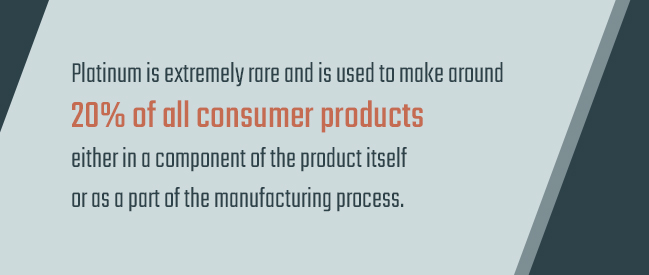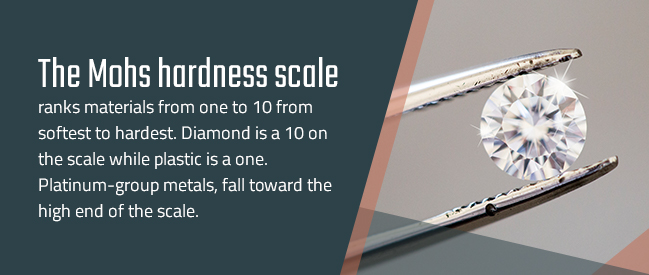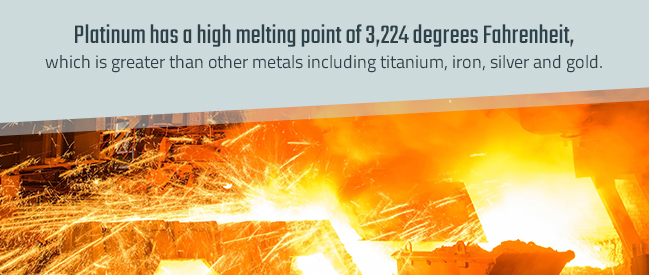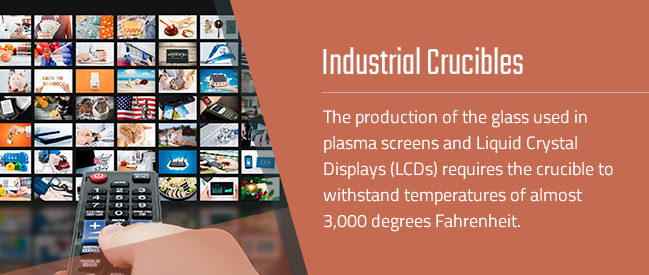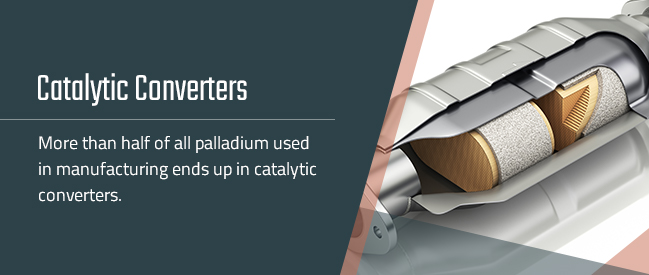Platinum is one of the most sought-after precious metals in the world, as much for its aesthetic appeal as for its durability, which makes it ideal for a number of industrial applications. Although platinum is extremely rare — more so than both gold and silver — it’s used to make around 20 percent of all consumer products either in a component of the product itself or as a part of the manufacturing process.
The term “platinum” is sometimes used to refer to all of a group of six metallic elements that appear together on the periodic table and have similar physical and chemical properties. These platinum-group metals, or PGMs, include:
The durability of PGMs is one of their most attractive properties. As noble metals, they resist corrosion and tarnishing and can stand up to high temperatures as well as stand the test of time. Because of platinum’s strength, it often serves as a protective coating for other less-sturdy metal surfaces through a process known as electroplating.
In the platinum electroplating process, workers attach the substrate — the object that needs to be plated — to a rack and dip it into an electrolyte solution in which platinum salts and ions are dissolved. The platinum connects to a positively charged electrode while the substrate attaches to a negatively charged electrode.
A DC electric current then flows through the rack to the platinum, oxidizing it, dissolving the platinum ions and depositing the ions onto the substrate. At the end of the process, you’ll have a platinum coating with a thickness of 0.5 to 5 microns.
This electroplating process allows equipment and components made of materials like silver or titanium to also have some of the beneficial characteristics of platinum. The durability of industrial platinum plating makes it an ideal choice for applications in a variety of industries, including the automotive, energy, medical and manufacturing sectors.
What Is Durability?
All these different industries use platinum plating because it’s highly durable and allows the equipment it coats to operate more efficiently over a longer period of time. But in what ways, exactly, is platinum plating so durable?
Increased Hardness
Adding a platinum coating to a softer material will increase its hardness and make it less susceptible to damage such as scratching or denting. You can measure the hardness of a material with the Mohs hardness scale, which ranks materials from one to 10 from softest to hardest. Diamond is a 10 on the scale while plastic is a one.
PGMs fall toward the high end of the scale. Platinum is a four to 4.5, palladium is a 4.75 and rhodium is a six. Although tungsten, titanium and hardened steel are harder than PGMs, few other metals are. Gold and silver both rank as a 2.5 to a three while tin is just a 1.5.
Increased Thickness
Adding a layer of platinum to a base material makes it thicker. This added thickness provides additional protection from damage, increases the quality and strength of the component and helps it last longer because there is more material to protect the substrate.
You can adjust the plating process to achieve your desired thickness, but the typical thickness is between 0.5 and five microns. It is possible, however, to achieve a thickness of 10 microns. A micron, also known as a micrometer, is one millionth of a meter. Although this may not seem like a large difference, an additional 0.5 to 10 microns of platinum adds a substantial amount of durability.
Wear Resistance
Every component is subjected to the wear and tear that comes with regular use. As a material comes into contact with other objects, it will eventually wear down due to friction. It will also suffer deterioration caused by abrasion, general material fatigue and other processes.
Adding an extra layer increases the amount of time that this process takes to cause significant damage. Using a durable material for plating, such as platinum, will increase an object’s lifespan by even more. This saves you money by reducing the amount of maintenance an item needs and the frequency with which you need to replace it.
Corrosion Resistance
Corrosion isn’t just unsightly — it also signals serious damage to equipment, since it is the gradual destruction of a material. Corrosion occurs when a metal interacts with something in its environment that causes it to break down. The most well-known form of corrosion is electrochemical oxidation, which occurs when a metal reacts with an oxidant. Rust is one common example of this.
Because corrosion is so destructive, it’s imperative that industrial operations protect their equipment from it as much as possible. This is one of the most valuable uses of platinum plating. It offers excellent corrosion resistance and often acts as a sacrificial barrier that slows or stops rust from forming on the surface below it.
Prevention of Tarnishing
Although tarnishing is essentially a minor form of corrosion, it’s often identified as a separate issue. Tarnishing reveals itself as a thin film that is black or gray in color on the surface of a material. Silver is especially susceptible to becoming tarnished, but the issue can occur on other metals, too, such as aluminum, brass and copper.
Although tarnishing is common with these metals, platinum is immune to it. For this reason, platinum plating is frequently used to prevent tarnishing, which is more cost-effective than attempting to remove it at afterwards with hand-sanding, abrasive blasting or another method.
Heat Resistance
In some applications, materials need to be able to withstand high temperatures. This is especially critical in industries such as the automotive, aerospace and energy generation sectors, but resistance to heat is also important for many other applications as well.
An extremely high temperature can, of course, melt a metal and destroy a component completely. Heating can also cause chemical deterioration known as high-temperature corrosion if a material encounters a hot environment that contains oxidizing compounds. Heat can also alter the properties of a metal. It can cause it to expand, become less hard and become more resistant to the passing of electrical current, which can cause electrical components to not work as intended.
Platinum plating can protect products from damage caused by high temperatures. Platinum has a high melting point of 3,224 degrees Fahrenheit, which is greater than other metals including titanium, iron, silver and gold. Because of this high heat resistance, coating an object in platinum can help protect it from heat-related damage.
Industrial Applications That Benefit From Platinum Plating’s Durability
When manufacturers need an item to withstand harsh conditions as well as the wear and tear of long-term use, they often turn to platinum. Its durability makes it ideal for a wide range of components in a number of different industries and applications, including some emerging technologies. Electroplating transfers platinum’s valuable properties to other materials as well.
Here are a few examples of uses for platinum plating that demonstrate its supreme durability.
Industrial Crucibles
The equipment used to manufacture chemicals and synthetic materials must be able to withstand high temperatures and resist corrosion. Platinum, rhodium and iridium are perfect for this application because of their high melting points and because they remain stable when subjected to heat. They also resist damage caused by the other materials used in these industrial processes.
One example is the production of crystals. The procedure for growing crystals requires the crucible to contain molten salts, so the crucible must be highly heat-resistant. The resulting crystals have uses in laser technology, electronics and medicine as well as uses such as drilling, cutting and engraving.
High-quality glass and glass fibers are manufactured via similar processes. The production of the glass used in plasma screens and Liquid Crystal Displays (LCDs) requires the crucible to withstand temperatures of almost 3,000 degrees Fahrenheit. Platinum also won’t react with glass, as some base metal alloys do, which maintains the purity of the glass.
Solar Cells
Researchers are currently looking for ways to efficiently store energy created with solar technology. They’re essentially attempting to create an artificial leaf, or photoelectrochemical cell. Platinum, it seems, will play a central role in these energy storage solutions.
These cells use a process called water electrolysis to split water into oxygen and hydrogen, which can then be used as fuel. Platinum is the most commonly used catalyst for this hydrogen evolution reaction. The metal’s durability and ability to function in acidic conditions allow it to consistently perform even over extended use in this application.
One group of researchers also found that copper plated with platinum performed better than the more expensive indium tin oxide (ITO) typically used as transparent electrodes in photoelectrolysis cells. In the study, the copper-platinum nanowires retained their conductivity despite bending and maintained high transmittance under all of the circumstances required for the process.
Thermal Barrier Coating for Gas Turbine Engines
In both commercial and military gas turbine engines, a thermal barrier coating, or TBC, protects the engine from heat damage and oxidation. This coating improves engine performance and prolongs the life of its components. Platinum plays an important role in forming the bond coat layer of the TBC.
Gas turbines employ platinum because it is non-reactive, resistant to corrosion and able to withstand high temperatures. Using gas to run an engine creates harsh conditions for the components inside of it. The materials used must continue to perform despite these circumstances. If they don’t, the results could be damaging to the equipment, dangerous to workers and cause power outages.
One group of researchers added a thin extra layer of platinum to the TBC to address the issue of molten droplets of calcium magnesium aluminum silicate (CMAS) and increase the effectiveness of the barrier.
Implantable Micro-Wire Multi-Electrode Arrays
Multi-electrode arrays are medical devices that essentially connect neurons in the brain to electronic circuitry in order to stimulate brain activity. Doctors have used these arrays in the treatment of neuropsychiatric disorders such as Parkinson’s disease, epilepsy and depression.
For implantable micro-wire multi-electrode arrays, coating the electrodes within platinum black has been shown to reduce the impedance of electrical signals, leading to the activation of more than twice the neurons of unplated microelectrodes. Using electroplating under ultrasonic agitation, known as “ultrasonic electroplating” or “sonicoplating,” has been shown to increase the durability of platinum black even further.
This means that implantable multi-electrode arrays could be more effective and longer-lasting thanks to the use of a specialized kind of platinum plating.
Catalytic Converters
The automotive industry frequently uses platinum plating to strengthen parts of vehicles and protect them from corrosion, wear and scratching. The PGM palladium is especially common because of its use in catalytic converters, which change toxic gases and pollutants created by internal combustion engines into less harmful gases. In fact, more than half of all palladium used in manufacturing ends up in catalytic converters.
Palladium’s hardness and resistance to corrosion and wear help make it the perfect material for use in catalytic converters. It will not oxidize when exposed to air and lasts much longer than other metals would under similar conditions. It also absorbs excess hydrogen in exhaust gas, which prevents the formation of hydrogen sulfide gas.
Medial Device Coating
Plating medical devices with platinum can help to increase their durability. This applies both to tools such as medical clamps and to devices implanted into the body, such as those used in hip and knee replacements. These implanted devices were traditionally made of steel, but today they might also be made of titanium or magnesium.
Any medical device must be able to come into contact with the human body without injury. Because of this, the plating must be smooth. It also needs to prevent the growth of harmful bacteria. Platinum fits these criteria and also increase the strength of a device and helps it to resist corrosion, which is crucial for creating a long-lasting solution to medical conditions.
Coating medical tools such as clamps and scalpels with platinum can also increase their strength and lifespan, improving their effectiveness and reducing the frequency with which medical facilities need to replace them, potentially lowering the cost of medical treatment.
Platinum Coatings from Sharretts Plating
These are just a few of the most impressive and exciting examples of how platinum plating improves equipment across various industries. You can find platinum in many other applications across a wide range of sectors.
Industry has used platinum group metals for years because of their many valuable attributes — especially their durability. These noble, precious metals have excellent strength and are resistant to wear, corrosion and heat. To attain these advantages for a larger group of materials and applications, today’s industries use platinum plating for both established and emerging devices.
At SPC, our experienced scientists and engineers use our perfected plating process to achieve high-quality results that will help your devices perform better and last longer through a variety of conditions and uses. To find out more about how we can help you with your commercial or industrial metal finishing needs, request a free quote through our website.



